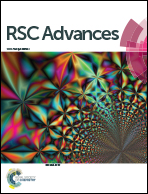Crosslinking of collagen using a controlled molecular weight bio-crosslinker: β-cyclodextrin polyrotaxane multi-aldehydes
Abstract
In this study, a series of β-cyclodextrins (β-CD) polyrotaxane multi-aldehydes with different molecular weight were prepared and then were used as crosslinker for collagen. The properties of crosslinked collagen were characterized by Fourier transform infrared spectrophotometry (FTIR), collagenase degradation assay, mechanical testing, scanning electron microscope (SEM) and in vitro cell studies. Compared to crosslinked by conditional crosslinkers, such as glutaraldehyde (GA) and N-ethyl-N-(3-dimethylaminopropyl)carbodiimide hydrochloride (EDC), the collagen crosslinked by the novel biocrosslinker has been improved effectively in biodegradation rate, compress modulus and show lower cytotoxicity. Besides, the modified collagen was suitable for the cell adhesion and proliferation due to the appropriate swelling property, porosity and pore size. Considering the excellent properties, β-cyclodextrins (β-CD) polyrotaxane multi-aldehydes is a novel crosslinker for collagen and the obtained collagen gel shows great potential to use as tissue engineering scaffold.


 Please wait while we load your content...
Please wait while we load your content...